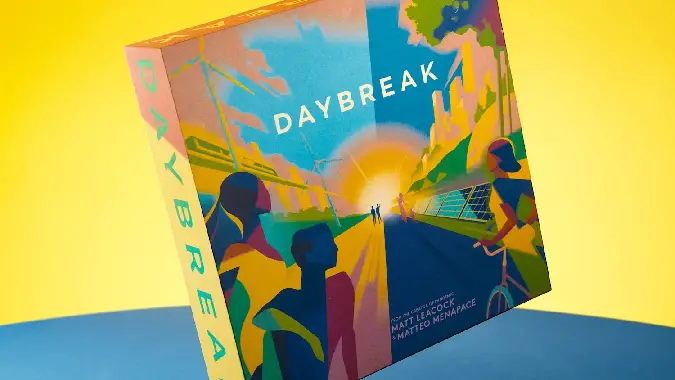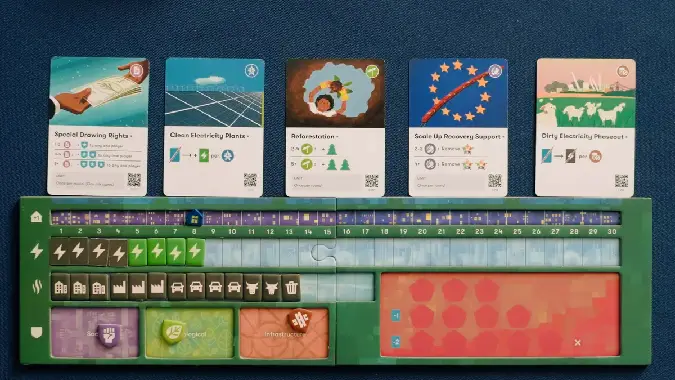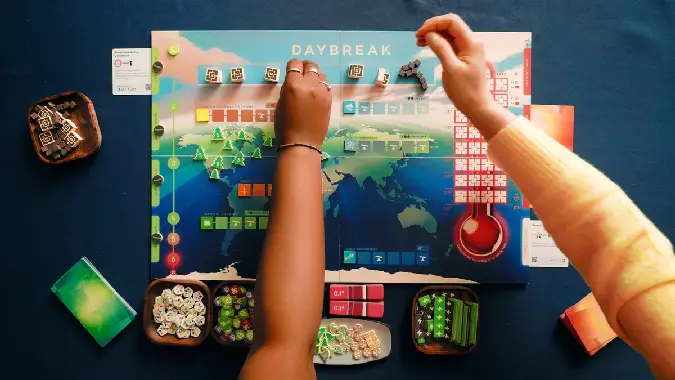The Daybreak board game lets you save humanity from climate change

The prospect of increasing global temperatures, rising sea levels, more intense weather systems, and the like can paint a pretty gloomy picture, but the board game Daybreak aims to paint a different picture. Daybreak is a cooperative board game where each player takes charge of a world power with the goal of dismantling the engine of global heating and stopping climate change in its tracks. It puts forth an unapologetically hopeful view of the near future in which with cooperation and achievable technologies, we can turn the tide and create resilient societies capable of thriving in this new world.
In Daybreak, each of up to four players take charge of either the United States, Europe, China, or the Majority World. As those world powers, those players build an engine consisting of up to five active project cards in front of each of them, with the goal of reducing their carbon emissions as much as possible while still supporting their communities with the energy and amenities they require. Players can use or further support those projects to increase their green energy output, reduce their carbon emissions, or increase their society’s resilience in a number of ways, all of which are crucial to victory. Should the players manage to achieve what’s called “drawdown” before time runs out, in other words if they reach a point where they collectively produce less carbon emissions than the planet is able to sequester, then the players win and humanity is saved! But if the global temperature rises too high or any player reaches a critical mass of communities in crisis, then everyone loses.

Image courtesy of CMYK Games
How gameplay works in Daybreak
Project cards are the primary unit of play in Daybreak. Players each start with five project cards in their tableau, each with one to three tags on it, on their player board and draw five more cards each round. Gameplay is very straightforward, with players being able to do one of three things in each action during a round.
- First, a player can utilize one of their active projects. This typically, but not always, requires discarding a project card from their hand, but is the primary way that players affect the world and work towards victory. One example of a card is “Clean Electricity Plants”, which allows a player to discard a card from their hand to add one clean energy production to their player board for each “grid” tag in the project; this card starts with one such tag, so each time a player activates it they discard one card to gain one clean energy production. Project cards can, by default, be activated as many times as the player can afford, though some are explicitly limited to fewer activations.
- Second, a player can tuck one of the project cards in their hand behind an active project stack in their tableau. This has the effect of adding that card’s tags, of which, again, it will have one to three, to the project stack it was added to, making that project more potent. To go back to the “Clean Electricity Plants” example from the previous bullet point, if the player tucked a card with a “grid” tag behind that project, then now “Clean Electricity Plants” has two grid tags to work with, meaning that each card discarded will generate two clean energy production, a significant improvement. This is the primary way that players grow in effectiveness over the course of the game.
- Finally, a player can take one of the project cards in their hand and place it in front of an active project stack in their tableau, replacing the project’s effect with that of the new card, but, critically, keeping all of the tags of the old stack. This allows players to pivot in new play directions as new and better projects become available to them, without necessarily sacrificing the project investments they’ve already made.
Players can take as many of these actions as they can afford each round, and the wise allocation of cards and tags into each project stack is crucial for victory.
While Daybreak is a hopeful game, it is by no means an easy one. Conquering climate change is a daunting task, and failure is certain without careful strategizing. As players make their choices and play their cards, things get worse on old planet Earth. At the end of every round, each player’s remaining carbon emissions, whether from dirty energy, industry, transportation, or other sources, are totaled up and added to the planet. Earth’s forests and oceans will sequester what carbon they can but, especially at the beginning of the game, it won’t be nearly enough. Excess carbon is added to the planet’s thermometer, increasing global temperatures. These rising temperatures have planetary effects, such as desertification, melting permafrost, and ocean acidification; as these effects reach tipping points, bad things happen which increase temperatures further and curtail the planet’s ability to sequester carbon. Increasing temperatures also lead to various global crises, which the world powers will need sufficient resilience to weather without their communities falling into crisis.

Image courtesy of CMYK Games
The real world implication of a board game
One interesting thing about Daybreak is that every card tells a story. You don’t just have to imagine what, say, “Direct Air Capture” is about based on the card title and art. Every card, be it a project card or a crisis card, features a small QR code that you can scan to get more information about it. I think that’s pretty neat. Another cool thing is that the makers of Daybreak put their money where their mouth is when it comes to sustainability. The game features no single-use plastics — indeed no plastics at all — nor does it feature any harmful textile products. All of the game’s components are 100% FSC certified wood, cardboard, and paper. The components don’t even come in those ubiquitous plastic baggies; instead the makers use small pulp storage trays to contain all of the play pieces.
I’ve played Daybreak a few times now and it’s definitely one that I would come back to. The gameplay is straightforward but has a good deal of depth to it. The challenge is just right for the game’s theme: daunting, but hopeful. And I absolutely love the game’s bright aesthetic. It’s been nominated for a number of board gaming awards, including the 2024 Kennerspiel, and I can absolutely see why. Maybe give it a chance yourself! Daybreak is published by CMYK and is available for purchase now.
Please consider supporting our Patreon!
Join the Discussion
Blizzard Watch is a safe space for all readers. By leaving comments on this site you agree to follow our commenting and community guidelines.




